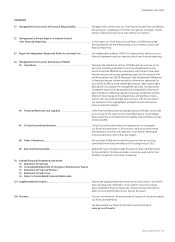GE 2011 Annual Report Download - page 42
Download and view the complete annual report
Please find page 42 of the 2011 GE annual report below. You can navigate through the pages in the report by either clicking on the pages listed below, or by using the keyword search tool below to find specific information within the annual report.’
40 GE 2011 ANNUAL REPORT
obligations through access to funding at reasonable market
rates, and credit risk is the risk of fi nancial loss arising from a
customer or counterparty failure to meet its contractual obli-
gations. We face credit risk in our industrial businesses, as well
as in our GE Capital investing, lending and leasing activities
and derivative fi nancial instruments activities.
•
LEGAL AND COMPLIANCE. Legal and compliance risk relates to
risks arising from the government and regulatory environment
and action, compliance with integrity policies and procedures,
including those relating to fi nancial reporting, environmental
health and safety, and intellectual property risks. Government
and regulatory risk includes the risk that the government or
regulatory actions will impose additional cost on us or cause
us to have to change our business models or practices.
Risks identifi ed through our risk management processes are
prioritized and, depending on the probability and severity of the
risk, escalated to the CRO. The CRO, in coordination with the CRC,
assigns responsibility for the risks to the business or functional
leader most suited to manage the risk. Assigned owners are
required to continually monitor, evaluate and report on risks for
which they bear responsibility. Enterprise risk leaders within each
business and corporate function are responsible to present to the
CRO and CRC risk assessments and key risks at least annually. We
have general response strategies for managing risks, which
categorize risks according to whether the Company will avoid,
transfer, reduce or accept the risk. These response strategies are
tailored to ensure that risks are within acceptable GE Board
general guidelines.
Depending on the nature of the risk involved and the particular
business or function affected, we use a wide variety of risk mitiga-
tion strategies, including delegation of authorities, standardized
processes and strategic planning reviews, operating reviews,
insurance, and hedging. As a matter of policy, we generally hedge
the risk of fl uctuations in foreign currency exchange rates, inter-
est rates and commodity prices. Our service businesses employ
a comprehensive tollgate process leading up to and through the
execution of a contractual service agreement to mitigate legal,
fi nancial and operational risks. Furthermore, we centrally man-
age some risks by purchasing insurance, the amount of which
is determined by balancing the level of risk retained or assumed
with the cost of transferring risk to others. We manage the risk of
fl uctuations in economic activity and customer demand by moni-
toring industry dynamics and responding accordingly, including
by adjusting capacity, implementing cost reductions and engag-
ing in mergers, acquisitions and dispositions.
GE CAPITAL RISK MANAGEMENT AND OVERSIGHT
GE Capital has a robust risk infrastructure and robust processes
to manage risks related to its businesses, and the GE Corporate
Risk Function relies upon them in fulfi lling its mission.
The GE Risk Committee was established to oversee GE
Capital’s risk appetite, risk assessment and management pro-
cesses previously undertaken by the GE Audit Committee. The
GECC Board of Directors oversees the GE Capital risk manage-
ment framework, and approves all signifi cant acquisitions and
dispositions as well as signifi cant borrowings and investments.
The GECC Board of Directors exercises control over investment
activities in the business units through delegations of authority.
All participants in the GE Capital risk management process must
comply with approval limits established by the GECC Board.
The Enterprise Risk Management Committee (ERMC), which
comprises the most senior leaders in GE Capital as well as the
GE CRO, oversees the implementation of GE Capital’s risk appetite,
and senior management’s establishment of appropriate systems
(including policies, procedures, and management committees) to
ensure enterprise risks are effectively identifi ed, measured, mon-
itored, and controlled. Day-to-day risk oversight for GE Capital is
provided by an independent global risk management organiza-
tion which includes the GE Capital corporate function in addition
to risk offi cers embedded in the individual business units. The
Risk Leaders in the business units have dual reporting relation-
ships, reporting both into the local business management and
also to the GE Capital corporate-level function leader, which fur-
ther strengthens their independence.
GE Capital’s risk management approach rests upon three
major tenets: a broad spread of risk based on managed exposure
limits; senior, secured commercial fi nancings; and a hold-to-
maturity model with transactions underwritten to “on-book”
standards. Dedicated risk professionals across the businesses
include underwriters, portfolio managers, collectors, envi-
ronmental or engineering specialists, and specialized asset
managers. The senior risk offi cers have, on average, over 25 years
of experience.
GE Capital manages risk categories identifi ed in GE Capital’s
business environment, which if materialized, could prevent GE
Capital from achieving its risk objectives and/or result in losses.
These risks are defi ned as GE Capital’s Enterprise Risk Universe,
which includes the following risks: strategic (including earnings
and capital), liquidity, credit, market and operational (including
fi nancial, compliance, information technology, human resources
and legal). Reputational risk is considered and managed
across each of the categories. GE Capital has made signifi cant
investments in resources to enhance its risk management infra-
structure, in particular with regard to compliance, market and
operational risk, liquidity and capital management.
GE Capital’s Corporate Risk function, in consultation with the
ERMC, updates the Enterprise Risk Appetite Statement annually.
This document articulates the enterprise risk objectives, its key
universe of risks and the supporting limit structure. GE Capital’s
risk appetite is determined relative to its desired risk objectives,
including, but not limited to credit ratings, capital levels, liquidity
























